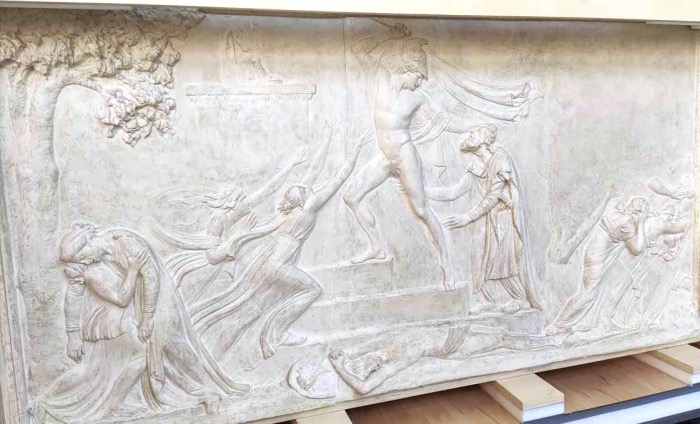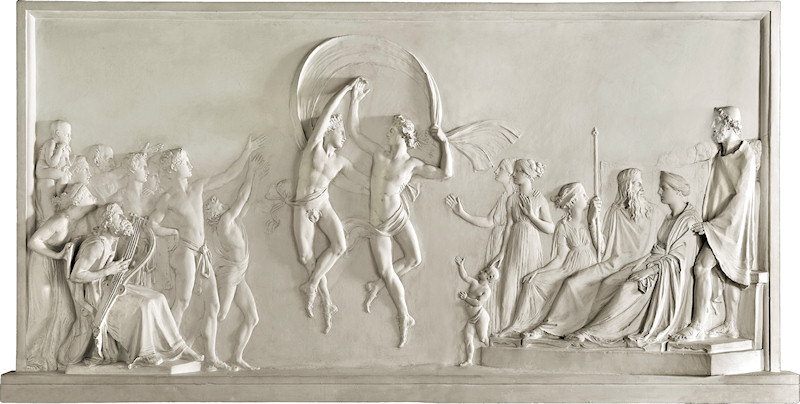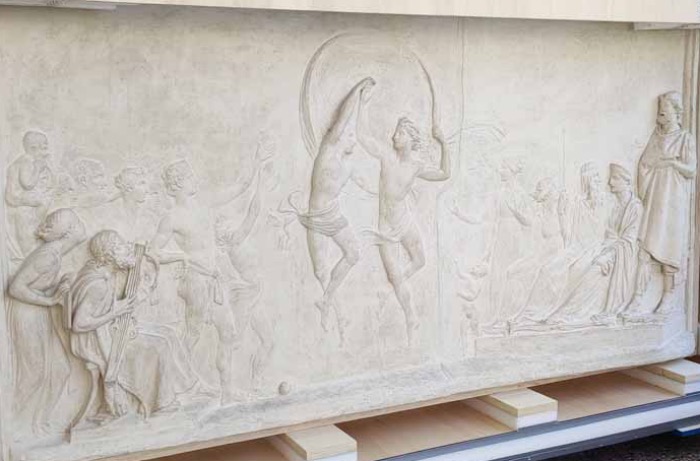
TWO WORKS BY ANTONIO CANOVA RETURN TO THEIR FORMER GLORY
Two works by Antonio Canova are returning to their former glory.
These are two original plaster casts by the sculptor, the property of Assicurazioni Generali, of large dimensions (141 x 280 cm), depicting two very different subjects: one created by the artist between 1787 and 1790, depicting “The Death of Priam”; the second, created later, depicting “The Dance of the Sons of Alcinoo”.
Both originally belonging to the Albrizzi Collection, they will be on public display in Treviso until 25 September 2022 and should be added to the list of works by Canova that are a must-see.
Two works by Antonio Canova

Antonio Canova, Danza dei figli di Alcinoo
Canova’s life is mixed with legend.
On the one hand there are the famous works and on the other there are the stories of Canova as a child prodigy who, in the Falier house in Asolo, invented a lion-shaped sculpture from a piece of butter.
What is certain is that Canova, even though he created sensational works, such as the famous Paolina Borghese, and even though he chose Rome as his city of choice, remained tied to his origins and his desire to transform matter into poetry.
Unforgettable, for example, is the Daedalus and Icarus that enabled him to obtain the money to move to Rome and complete his training.
Now two works by Antonio Canova have returned to their former glory and are on display for the first time in Treviso.
THE DEATH OF PRIAM BY ANTONIO CANOVA
Pain and anguish are the dominant elements of the first bas-relief that has returned to its former glory: The Death of Priam.
Priam is naked and Canova offers him to the viewer’s gaze so that he can understand the full tragic nature of the moment.
Then there are Priam’s daughters who, on the left, with their arms outstretched upwards, beg for mercy; on the right, they flee and one clutches her child; on the far left, Priam’s wife faints.
Finally, Priam’s wife, on the far left, faints and is supported with difficulty.
THE DANCE OF THE SONS OF ALCINOO BY ANTONIO CANOVA
The second bas-relief that has been given new life is the ‘Dance of the Children of Alcinous’ in which joy and grace are the protagonists.
Again, the episode is inspired by the events of the Trojan War and the epic of Ulysses, drawing on the Odyssey and Book II of the Aeneid.
TWO WORKS BY CANOVA THAT ARE SERIAL
The series of plaster bas-reliefs are part of what can be described as a serial production but also highlight the characteristics that allow Canova to be defined as the first modern artist.
These works are a demonstration of the competition the sculptor engaged in to sustain the primacy of his art over painting: works therefore of a narrative nature.
The challenge is even greater when the artist asks sculpture to forget about weight and become light.
Dance, for lightness of movement, is as daring as Antonio Canova could have conceived.
The path begun by “The Dance of the Sons of Alcinous” will lead him to the Dancers, with hands on hips, finger on chin, cymbals, testifying that nothing is impossible for sculpture when the creator is Canova.

THE TWO WORKS BY ANTONIO CANOVA ON DISPLAY IN TREVISO
From 14 May to 25 September 2022, the two works by Antonio Canova can be admired at the new Bailo Museum on the occasion of the exhibition “Canova gloria trevigiana: dalla bellezza classica all’annuncio romantico” (Canova Glory of Treviso: from Classical Beauty to Romantic Proclamation), curated by Fabrizio Malachin, Giuseppe Pavanello and Nico Stringa.
An event that brings together more than 200 works by Canova, most of which have never been exhibited to the public.
CANOVA GLORIA TREVIGIANA
From classical beauty to romantic announcement
Treviso, Bailo Museum
14 May 2022 – 25 September 2022
The exhibition has also recreated the setting planned by Canova at Palazzo Papafava, where the Ancient/Modern comparison is taken to its maximum essence: Apollo of the Belvedere compared to Perseus Triumphant, and the Borghese Gladiator, another celebrated work, compared to the Creugante.
For the first time, the works are also displayed on their original plinths restored for the occasion.

